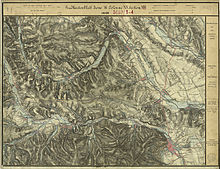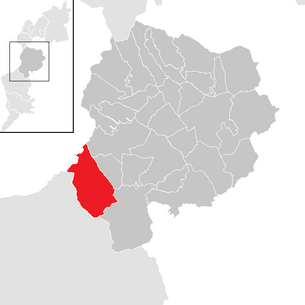Pilgrim village
|
Pilgrim village
|
||
|---|---|---|
| coat of arms | Austria map | |
|
|
||
| Basic data | ||
| Country: | Austria | |
| State : | Burgenland | |
| Political District : | Oberpullendorf | |
| License plate : | OP | |
| Surface: | 43.87 km² | |
| Coordinates : | 47 ° 26 ' N , 16 ° 21' E | |
| Height : | 375 m above sea level A. | |
| Residents : | 1,629 (January 1, 2020) | |
| Population density : | 37 inhabitants per km² | |
| Postal code : | 7441 | |
| Area code : | 02616 | |
| Community code : | 1 08 17 | |
| NUTS region | AT111 | |
| Address of the municipal administration: |
Kirchschlager Str. 2 7441 Pilgersdorf |
|
| Website: | ||
| politics | ||
| Mayor : | Ewald Bürger ( ÖVP ) | |
|
Municipal Council : ( 2017 ) (21 members) |
||
| Location of Pilgersdorf in the Oberpullendorf district | ||
 Pilgersdorf municipal office |
||
| Source: Municipal data from Statistics Austria | ||
Pilgersdorf ( Hungarian : Pergelin , Croatian : Pilištrof ) is a large community with 1629 inhabitants (as of January 1, 2020) in Burgenland in the Oberpullendorf district in Austria .
geography
The community is located in Central Burgenland on the Zöbernbach between Kirchschlag in the Bucklige Welt and Lockenhaus .
Community structure
Localities (and at the same time cadastral communities ) of the large municipality are (population as of January 1, 2020):
- Bubendorf in Burgenland (294 inhabitants, area 642.31 hectares , altitude 371 m above sea level ) including parish settlement,
- German Gerisdorf (194 inhabitants, area 723.31 hectares , altitude 358 m above sea level ),
- Kogl in Burgenland (105 inhabitants, extension 517.93 hectares , altitude 599 m above sea level ),
- Lebenbrunn (127 inhabitants, extension 444.82 hectares , altitude 548 m above sea level ) including Rotleiten,
- Pilgrim village (584 inhabitants, 1,199.91 hectares in size , 375 m above sea level )
- Salmannsdorf (120 inhabitants, extension 495.59 hectares , altitude 479 m above sea level ) and
- Steinbach in Burgenland (205 inhabitants, extension 366.64 hectares , altitude 411 m above sea level ) including Gschorrholz.
Incorporations
Today's large community was created in 1971 from the amalgamation of the previously independent communities Pilgersdorf, Bubendorf, German Gerisdorf, Lebenbrunn, Kogl, Salmannsdorf and Steinbach.
history
Before the birth of Christ, the area was part of the Celtic Kingdom of Noricum and belonged to the surroundings of the Celtic hill settlement Burg on the Schwarzenbacher Burgberg .
Later under the Romans, today's pilgrim village was then in the province of Pannonia .
Burgenland archaeologists found a small Roman cemetery from the 1st century AD in the area of the old school around 1980. The place was first mentioned under the name "Brunnaron am Zöbernbach" in a deed of gift from King Ludwig the German in 844. In it, the king bequeathed his chancellor Dominicus a manor near Brunnaron on the border between the counties of Ratpots and Rihheris . In 860 the "Church of Minigo" (= Dominicus) was mentioned. In the 10th century, the Magyars advancing from the east destroyed Brunnaron. From this time there are some finds, a bronze wire ring with a glass bead and wall remains of a Romanesque church. In the 12th century, German colonists founded a new settlement on the ruins and built a large church (32 × 14 meters).
The first documented mention of the pilgrim village comes from the year 1225 under the name "Pylgrim": "Via magna, quae de villa Pylgrim venit" (German: "Great street that comes from the place Pylgrim"). In 1289 the fortified place in the Güssing feud was destroyed by the troops of the Habsburg Duke Albrecht . At the beginning of the 14th century, today's parish church was built, which is dedicated to St. Aegidius. The parish was probably looked after by the Lockenhauser Franciscans . In 1390 the Kanizsay were inaugurated as the landlords of Lockenhaus and "Pergelim with its toll" is named as a place that belonged to the Lockenhaus rule.
From 1447 to 1488 Pilgersdorf was pledged to the Pottendorfer, the lords of Kirchschlag and Krumbach . While the Turks besieged Güns, Pilgersdorf was devastated in 1532.

From around 1570 to 1645 the landlords and the population were Protestants . At that time, the dead were buried around the ruins of the old church. The judge from Pilgersdorf also looked after the new clearing settlements of Kogl, Lebenbrunn and Steinbach . The stately mill is already mentioned in 1597.
The place was completely burned down in 1605 by the Bocskay- Haiduks (Turks and Tatars), in 1608 only 18 of 29 feudal people began to rebuild their houses. In the first half of the 17th century, Carinthian and Styrian aristocrats settled in Pilgersdorf (Speidl, Preinberger, Hohenwart, Globitzer, Mensdorff and Hoden), who managed half or full sessions. From 1640 to 1661 the landlord, Count Franz von Nádasdy, Baron Speidl and his family pledged the place and allowed him to build the “Big House” in 1642 (construction costs around 3000 guilders). In 1649 the first school was attested (wooden house). Because the Lockenhauser Augustinians did not use the vicarage from 1660 on, the teachers used it as a school.
From 1660 to 1800 the Augustinian hermits looked after the parish and carried out the re-Catholicization, which they did not quite succeed with the aristocrats, because in 1780 there were still ten Protestants (Preinberger family and house staff). In 1671 the stately inn in the center of the village was mentioned for the first time and in 1672 a second mill was also mentioned. From 1703 to 1711 the place was plundered several times by rebellious Kuruc . In 1750, many people fell victim to the plague . In 1783 the church was rebuilt and expanded to the east. After the parish was founded in Kogl in 1789, the Pilgersdorfer shrank and in the following years the parish was looked after by world priests. Pilgersdorf burned down in 1804.
Population development

Since the first census in 1869, in which 2,333 inhabitants were counted, the population has steadily decreased and reached its all-time low on January 1, 2010 with 1,642 inhabitants. Compared to 1869, in 2010 Pilgersdorf only had 70% of the population at that time. The negative population development results almost exclusively from the sharp decline in the birth rate.
Culture and sights
- Catholic parish church Kogl hl. Oswald
- Catholic parish church Pilgersdorf hl. Aegidius
- Catholic branch church Bubendorf in Burgenland hl. Florian
- Catholic branch church Lebenbrunn hl. Ulrich
Memorial to the fallen and missing of the First and Second World Wars .
politics
Municipal council
The municipal council has 21 members.
The council comprises a total of 21 members based on the number of eligible voters.
| Political party | 2017 | 2012 | 2007 | 2002 | 1997 | ||||||||||
|---|---|---|---|---|---|---|---|---|---|---|---|---|---|---|---|
| Sti. | % | M. | Sti. | % | M. | Sti. | % | M. | Sti. | % | M. | Sti. | % | M. | |
| ÖVP | 967 | 74.56 | 16 | 790 | 64.86 | 14th | 886 | 68.74 | 15th | 905 | 71.04 | 16 | 839 | 70.45 | 14th |
| SPÖ | 330 | 25.44 | 5 | 380 | 31.20 | 7th | 403 | 31.26 | 6th | 329 | 25.82 | 5 | 310 | 26.03 | 5 |
| FPÖ | not running | 48 | 3.94 | 0 | not running | 40 | 3.14 | 0 | 42 | 3.53 | 0 | ||||
| Eligible voters | 1566 | 1564 | 1568 | 1517 | 1444 | ||||||||||
| voter turnout | 87.93% | 82.93% | 86.86% | 88.46% | 88.43% | ||||||||||
Parish council
In addition to Mayor Ewald Bürger (ÖVP) and Vice Mayor Josef Thurner (ÖVP), the executive councils Robert Bürger (ÖVP), Franz Kainz (ÖVP), Thomas Renner (ÖVP), Thomas Ruf (SPÖ) and Josef Weber (ÖVP) belong to the Parish council.
Robert Bürger (ÖVP) was elected to the municipal treasurer and Franz Kainz (ÖVP) was elected to the environmental council.
Alexandra Heissenberger (ÖVP, for Kogl), Franz Kainz (ÖVP, for Salmannsdorf), Johann Stifter (ÖVP, for Bubendorf), Josef Thurner (ÖVP, for Gerisdorf in Germany), Josef Weber (ÖVP, for Lebenbrunn) and Anton were appointed mayors Wilfinger (ÖVP, for Steinbach) appointed.
mayor
Mayor is Ewald Bürger (ÖVP). He was elected successor to Heinrich Harter (ÖVP) with 72.98% in the 2007 direct mayor election. After Bürger did not have a competitor in the 2012 election, Thomas Ruf ran for the SPÖ in the election on October 1, 2017. Bürger was re-elected as mayor with 76.50%, while Ruf only got 23.50%.
At the constituent meeting of the municipal council, Josef Thurner (ÖVP) was elected deputy mayor.
The head of office is Marlene Zigling.
Personalities
- Josef Schermann , Roman Catholic theologian, liturgist and religious educator
literature
- Josef Schermann: Exhibition "Documents and photos on the history of Pilgersdorf" , in Burgenland Mitte issue no. 52 1982
Web links
- 10817 - pilgrim village. Community data, Statistics Austria .
Individual evidence
- ↑ Statistics Austria: Population on January 1st, 2020 by locality (area status on January 1st, 2020) , ( CSV )
- ↑ Statistics Austria: dissolutions or associations of municipalities from 1945
- ↑ Uta von Freeden, Herwig Friesinger, Egon Wamers (ed.): Faith, cult and rule. Phenomena of the Religious. Colloquia on prehistory and early history. Volume 12, Roman-Germanic Commission of the German Archaeological Institute, Frankfurt am Main 2009, ISBN 978-3-7749-3663-8 , p. 400ff.
- ↑ Statistics Austria: Pilgersdorf community - population development 1869–2010 (PDF file, 62 kB; accessed on August 25, 2010)
- ↑ Statistics Austria: Pilgersdorf community - components of population development (PDF file, 9 kB; accessed on August 25, 2010)
- ↑ a b Province of Burgenland: election results Pilgersdorf 2017 (accessed on January 1, 2018)
- ^ Province of Burgenland: election results Pilgersdorf 2012 (accessed on January 1, 2018)
- ↑ a b Province of Burgenland: election results Pilgersdorf 2007 (accessed on January 1, 2018)
- ↑ a b Province of Burgenland: election results Pilgersdorf 2002 (accessed on January 1, 2018)
- ↑ a b c d Pilgersdorf community: [ Our community, issue 1/2017 ] (PDF document; accessed on January 1, 2018)
- ^ Pilgersdorf community: staff (accessed on January 1, 2018)







